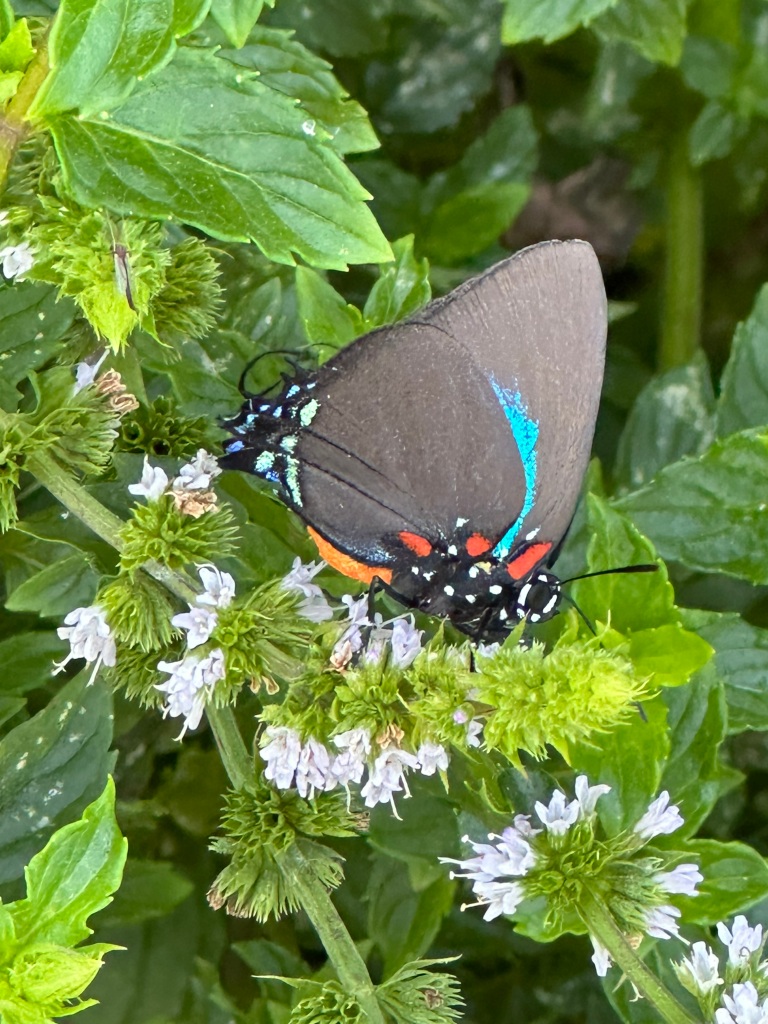
Mistletoe (Phoradendron leucarpum) is a curious plantwith thirty speciesnative to North America. It is hemiparasitic, meaning is it partially dependent on another plant for subsistence. Host trees include over sixty species, like maple, ash, oak, walnut, willow, and elm. The “hemi” part of the hemiparasitic means it can photosynthesize for itself, but is still dependent on host trees for support, water, and nutrition. This is reflected in the genus name Phoradendron which is Greek for “tree thief.”
The origin of kissing under the plant is unclear. Some sources say in the 1500s, there was to be one kiss for each berry. When the berries had all been plucked, the kissing ended. Not a very satisfying story. Plus, I’ve rarely seen it with berries, so where does that leave an amorous couple?
In days of yore, plants that remained green during the winter, such as holly, mistletoe, and conifers, were symbols of life and hope during the cold, dark winters. But why kissing? We don’t kiss under holly and pick off the berries, or under the hemlock and pick off the cones. Or maybe you do…
To find mistletoe, look up into the crown of large non-evergreens for a patch of green leaves when the tree is otherwise bare. The green ball of leaves can grow to 5’ wide and persists year-round. The masses are widely used for nesting bases by many animals, from tiny chickadees to large owls and squirrels.
The 3-6mm white berries are purported to be poisonous, though many songbirds and mammals dine on the berries without ill effects. Birds and squirrels are common vectors for depositing seeds from within the sticky berries. Mistletoe translates from Anglo-Saxon as basically, “dung on a twig.” How romantic!
Once seeds within the berries embed in the bark, they grow a kind of root called a haustorium into the vascular tissue (cambium) of the tree. The parasitic plant grows slowly for 3-5 years before producing flowers. Mistletoe is dioecious so only female plants produce berries.
I used to think mistletoe was one plant I could remove from my landscape without question. Then I learned Great Purple Hairstreak butterflies are dependent on it. Great Purples are one of our most resplendent butterflies with patches of metallic cerulean blue and lime green, red, orange, and white, on black. About the only color it isn’t, is purple. Hairstreak butterflies lay eggs on the leaves of mistletoe—its only larval host plant—and caterpillars hatch to munch on the plant. Adult butterflies also feed on the nectar of mistletoe flowers. Again, I learn that all native plants and animals have a reason to be here.

Though poisonous or at least irritating to digestion, there is some evidence mistletoe can be helpful to ease the side effects of chemotherapy and may be effective against certain cancers. However, this is a “don’t try this at home” situation; more research is needed. It is poisonous to pets, so if you have a sprig indoors, keep all parts of the plant away from Fluffy and Bruno.
To remove mistletoe to protect the tree, snip or snap it off at the base. However, to fully remove it, the host branch must be removed because the haustoria grows through the tree’s tissue, not just at the point of attachment. Since there is no way I can reach the mistletoe in our trees, and it provides a nursery for some fantastic critters, it will be staying where it is.
Thanks to the National Wildlife Foundation for some facts for this article. NWF.org.
